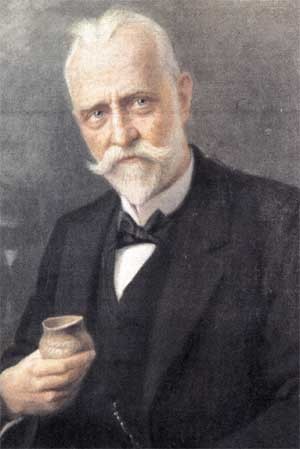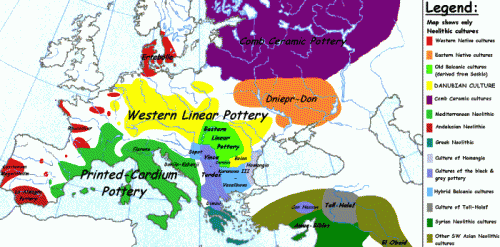dimanche, 24 juillet 2011
Archeological Cultures
Archaeological Cultures
By Andrew HAMILTON
Ex: http://www.counter-currents.com/
In the attempt to understand who we are and where we came from, history takes us only so far. Once the written record thins and ends—not far back in time, evolutionarily speaking—we are left primarily with archaeological evidence and inferences from linguistics.
Prehistory is a world of few facts and much guesswork. In the early historical period, when archaeological evidence and spotty written records at least complement one another, existing knowledge is extended. But when the historical record ends completely and archaeologists take over, the situation becomes much more opaque.
The unit of prehistorical analysis is the “culture,” characterized by a defined range of material artifacts. Cultures may be named after particularly rich geographical sites, after unique artifacts, or after regions in which sites of a certain type frequently occur. For each culture a geographical distribution can be mapped and radiocarbon dating pinpoint an estimated date and duration. A series of prehistorical maps can be drawn showing sequences of cultures analogous to sequences of peoples and states on historical maps.
Therefore, cultures should be visualized both “horizontally” and “vertically.” The horizontal dimension is a culture’s geographic distribution, the vertical its development, persistence, and disappearance across time, as well as the sequential succession of different cultures.
Thus, cultural change in prehistoric Europe can be envisioned as a shifting mosaic of different cultures (white ethnic groups or “populations”) moving across the continental landscape in both time and space.
Kossinna’s Law
 The term “culture” entered archaeology through 19th century German ethnography, where the Kultur of tribal groups and rural peasants was distinguished from the Zivilisation of urbanized peoples. Kultur was used by German ethnologists to designate the distinctive ways of life of a particular people or Volk.
The term “culture” entered archaeology through 19th century German ethnography, where the Kultur of tribal groups and rural peasants was distinguished from the Zivilisation of urbanized peoples. Kultur was used by German ethnologists to designate the distinctive ways of life of a particular people or Volk.
The idea of archaeological cultures became central to the discipline in the 20th century thanks to the work of Gustaf Kossinna (1858–1931) of the University of Berlin, the most famous archaeologist in the German-speaking world of his day (he was also a linguist).
Kossinna perceived the archaeological record as a mosaic of clearly defined cultures (Kultur-Gruppen or culture groups) that were strongly associated with race. He was particularly interested in reconstructing the movements of direct prehistoric ancestors of Germans, Slavs, Celts and other Indo-European ethnic groups in order to trace the Aryan race to its homeland or Urheimat.
Kossinna developed the theory that regionally delimited ethnic groups can be defined by the material cultures identified by archaeologists. A unified set of archaeological artifacts, a culture, was the sign of a unified ethnicity: “Sharply defined archaeological cultural areas correspond unquestionably with the areas of particular people or tribes.”
This statement is known as “Kossinna’s law.” The only objection to it is the imputation of an invariable identity between archaeological cultures and ethnic or racial groups (populations). The science is more complicated than that.
Kossinna’s law applies best to Neolithic and subsequent eras. The advent of agriculture was accompanied by a population explosion—the Neolithic Demographic Transition. By contrast, in the earliest human era, the Paleolithic, distinct cultural groups and differences are less readily discernible in the archaeological record.
Kossinna’s ideas have made him anathema to guardians of the racial Zeitgeist. Symptomatic of the dumbing down of academia, he is invariably depicted as a proto-Nazi.
Unfortunately, Kossinna’s “academic racism” is warm tap water compared to the poisonous brew of any of the hundreds of professors of Jewish Studies, Holocaust Studies, “Whiteness Studies,” Asian Studies, African Studies, Native American Studies, and Latino Studies active in universities today. Kossinna and other white academics routinely vilified as “racists” are sorry contenders for the mantle. For real hate you must examine today’s academy.

The Linear Pottery Culture
Kossinna’s concept of archaeological culture was introduced into the English-speaking academy by Australian-born, English-descended Stalinist archaeologist V. Gordon Childe, who stated in The Danube in Prehistory (1929):
We find certain types of remains—pots, implements, ornaments, burial rites, house forms—constantly recurring together. Such a complex of regularly associated traits we shall term a “cultural group” or just a “culture.” We assume that such a complex is the material expression of what today would be called a people.
Noted for synthesizing archaeological data from a variety of sources, Childe was the first academic to construct a prehistory of the entire European continent (The Dawn of European Civilization, 1925). He also wrote The Aryans: A Study of Indo-European Origins (1926), a cause for discomfort among the politically correct today.
Examples of very early Neolithic cultures in Europe include the Starčevo-Kőrös-Criş culture [3] (Serbia-Hungary-Romania) and the Karnavo culture of Bulgaria.
The first agrarian society in central and eastern Europe was the Linear Pottery culture (Linearbandkeramik, LBK), formerly known as the Danubian culture after V. Gordon Childe’s book. Starting around 5500 BC from the middle Danube (Bohemia, Moravia, Hungary) it expanded northward along the Rhine and the other rivers going north through the German and Polish plains toward the North Sea.
According to McEvedy’s hypothesis in 1967,
Given that the Danubians were a genuine people and remained so until provincial differences began to appear among them a millennium after they had expanded across central Europe, it is difficult to avoid the view that their movement created an Indo-European heartland which must be postulated for roughly this time and place on purely linguistic grounds. Therefore the Danubian culture represents the arrival and establishment of the Indo-Europeans in Central Europe. (Colin McEvedy [5], The Penguin Atlas of Ancient History, 9)
Limitations of the Culture Concept
By definition, a prehistory in racial and ethnic terms remains hypothetical. Despite its popularity as a means of organizing the archaeological record, a simple correlation between peoples and distinctive archaeological cultures is not always warranted.
Nevertheless, as Colin McEvedy observed 45 years ago, “We are not so helpless in this matter as the puritans pretend.” And Indo-Europeanist archaeologist J. P. Mallory adds, “While one may deny the necessity of assuming an invariable one-to-one correlation between an archaeological [culture] and a linguistic entity, it is equally perverse to assume that there can be no correlation between the two.” (In Search of the Indo-Europeans: Language, Archaeology and Myth, 1989, 164. Emphasis added.)
It will likely soon be possible to make well-founded inferences about the genotypes of ancient populations from DNA analyses of human remains. To a limited extent this is already occurring.
It is perfectly acceptable to make reasonable predictions and assumptions about white prehistory based upon archaeological, linguistic, anthropological, and genetic evidence. Archaeologists and prehistorians formulate analogous hypotheses and assumptions about scores of matters all the time.
What is not acceptable is to deny prehistoric evidence due to racist-ideological dogmas motivated by the determination that whites must and will be denied a sense of collective identity.
People so motivated are keenly aware that the development of identity among whites akin to that enjoyed by Jews and non-whites could derail the genocidal policies upon which contemporary politics and the culture war are predicated.
Article printed from Counter-Currents Publishing: http://www.counter-currents.com
URL to article: http://www.counter-currents.com/2011/07/archaeological-cultures/
00:05 Publié dans anthropologie, archéologie, Traditions | Lien permanent | Commentaires (0) | Tags : néolithique, néolithique européen, préhistoire, protohistoire, histoire, europe, europe préhistorique, archéologie |  |
|  del.icio.us |
del.icio.us |  |
|  Digg |
Digg | ![]() Facebook
Facebook



Les commentaires sont fermés.